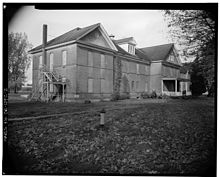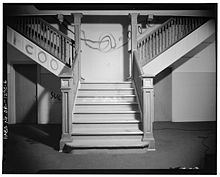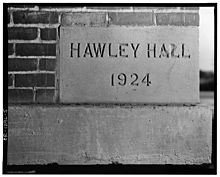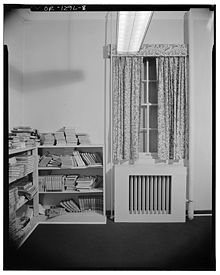- Chemawa Indian School
-
For other uses, see Chemawa (disambiguation).
Chemawa Indian School 
Hawley Hall porch Address 3700 Chemawa Road NE
Salem, Oregon, Marion County, 97305
 United States
United StatesCoordinates 45°00′00″N 122°59′05″W / 45.00004°N 122.984712°WCoordinates: 45°00′00″N 122°59′05″W / 45.00004°N 122.984712°W Information Type Public Opened 1880 Authority Bureau of Indian Affairs[1] Superintendent Jonathan Claymore[1] Principal Theodore Mack[1] Grades 9-12[2][3] Number of students 425[2] Color(s) Red, white, and black [1] Athletics conference OSAA PacWest Conference 3A-3 Mascot Braves[1] Accreditation(s) NAAS[2] Website http://www.chemawa.bie.edu/ Chemawa Indian School (
 /tʃɨˈmɑːwə/) is a Native American boarding school in Salem, Oregon, United States. It was opened on February 25, 1880[4] as an elementary school, but as of 2005, served ninth through twelfth grades. It is sometimes referred to as Chemawa High School. The Chemawa Indian School is the oldest continuously operating Native American boarding school in the United States and numbers its graduates in the thousands. Former names for the school include United States Indian Training and Normal School, Salem Indian Industrial and Training School and Harrison Institute.[5][6]
/tʃɨˈmɑːwə/) is a Native American boarding school in Salem, Oregon, United States. It was opened on February 25, 1880[4] as an elementary school, but as of 2005, served ninth through twelfth grades. It is sometimes referred to as Chemawa High School. The Chemawa Indian School is the oldest continuously operating Native American boarding school in the United States and numbers its graduates in the thousands. Former names for the school include United States Indian Training and Normal School, Salem Indian Industrial and Training School and Harrison Institute.[5][6]Contents
History
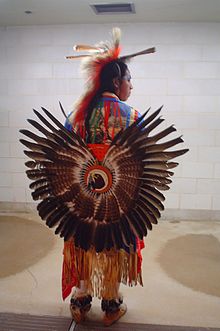 Dancer in traditional regalia attends a Pow-wow at Chemawa Indian School
Dancer in traditional regalia attends a Pow-wow at Chemawa Indian School
The history of the Chemawa Indian School dates back to the 1870s when the U.S. Government, based on the theories of Captain (later Brigadier General) Richard Henry Pratt, authorized a school for Native American children in the Pacific Northwest region of the United States. It was the second such school, after the Carlisle Indian School near Harrisburg, Pennsylvania. Pratt's philosophy was to integrate the Native American population into general society through education. This contrasted to the earlier philosophy, which assumed that Indians were inherently different from whites, and that no education could "civilize" them. The schools founded under Pratt's influence were deliberately located far from Indian reservations, in order to separate the students from traditional ways of life.[7]
A site was chosen at Forest Grove, Oregon on four acres (16,000 m²) of land rented from Pacific University. Lieutenant Melville Wilkinson, a member of the United States Army and Secretary to General O.O. Howard, was in charge of the project. $5,000 was provided to start the school. Lt. Wilkinson, with the help of eight Puyallup Indian boys began construction on the buildings in 1880. The initial class of students consisted of fourteen boys and four girls. All the students came from the State of Washington, seventeen of them from the Puyallup Indian reservation on Puget Sound and one boy from the Nisqually Indian reservation. These students were taught blacksmithing, shoemaking, carpentry, wagon making, girl's industries, and advancement in studies.
Prior to 1883, the United States Congress planned to appropriate a larger amount of funds for the Chemawa Indian School. Several factors led to the search for a new site for the school, including local resistance to the school, a need for more land to teach farming skills, and the destruction of the girl's dormitory by fire in 1884.
At this point, officials looked at the temporary leased nature of the land, as well as the poor drainage, and began considering alternative sites around the Willamette Valley. Three sites were donated for the new school. Newberg, Oregon offered 100 acres (400,000 m²) of heavily timbered land, 23 acres (93,000 m²) near Forest Grove, Oregon with a pasture parcel of 75 acres (304,000 m²) approximately four miles (6 km) away from the main site, and 171 acres (692,000 m²) partially cleared, sparsely timbered land in Salem, Oregon, served by a spur of the main railroad through the Willamette Valley. School officials chose the Salem site since it was close to Oregon's Capital and had the most land.
In 1885, the school moved to the site five miles (8 km) north of Salem, Oregon and began construction. The first buildings were made of wood, and were later razed to make way for more permanent brick structures. On June 1, 1885, the Chemawa Indian School was opened with approximately half of the students moving to the new location and half staying behind in Forest Grove, Oregon. On October 1, 1885, Mr. John Lee became superintendent of Chemawa Indian School (then known as Salem Indian Training School). After a winter of separation, and after staff and students finished construction on three new buildings on the campus, he withdrew the remaining students from Forest Grove, Oregon and reunited them all on the Salem, Oregon campus.
The first graduating class completed the sixth grade in 1886. Subsequently, courses were added through the tenth grade. In 1900, the school had 453 students, the largest of its kind in Oregon with a federal budget of $57,182.62. The emphasis at that time was on vocational education.
The 1913 report lists farming as one of the major areas of training. Dairy farming, animal husbandry, and other farm methods provided food which was preserved by the students for later use. A school library provided reading material and students could participate in basketball, baseball, and American football. There were 690 students enrolled with 175 Alaskan children.
By 1922, there were 70 buildings on the 40-acre (160,000 m2) campus. Most of the buildings were wood frame, but some of the newer ones were of brick construction. The land area of the school had grown to 426 acres (1.72 km2). Some of the land had been purchased by Native American students and given to the school as a token of their gratitude, with the money earned by picking hops.
The year 1926 saw the peak enrollment at Chemawa with almost 1,000 students enrolled. 11th and 12th grades were added to the curriculum and all grades below 6th were dropped. In 1927, Chemawa became a fully accredited high school.
the school was threatened with closure in the early 1930s, as an economy move due to the Great Depression. Interested journalists and Oregon's delegation to the U.S. Congress lobbied with the Bureau of Indian Affairs to keep it open, and it continued with 300 students.
Lawney Reyes, who attended the school in 1940–1942 (as did his sister, Luana Reyes), devotes two chapters of his memoir White Grizzly Bear's Legacy: Learning to be Indian to his experiences there. He wrote that his consciousness of being "Indian" was largely formed through his conversations there with other students.[8]
He also wrote:
I did not experience any harsh restraint against Indian culture or tradition at Chemewa. Generations of Indians before me had already felt the full force of that practice. I learned that in earlier years, speaking the Indian language had been forbidden. White authority had dealt harshly with Indian dancing, singing, and drumming. Students were not allowed to braid their hair or wear any ornaments with Indian design motifs. During my time, efforts to teach the white way were still in force, but attempts to abolish or restrain Indian culture were past. The practice of Indian culture, however, was not encouraged or discussed.[9]
The 1940s and 1950s brought other changes, including a special program for Navajo Nation students and changes in policy to bring back Pacific Northwest students, particularly those from Alaska. In the late 1970s, Chemawa moved to a new campus on adjacent land, with most of the original brick buildings being destroyed.
National Register of Historic Places
The school's Colonial Revival-style hospital and four other structures were listed on the National Register of Historic Places (NRHP) as the Chemawa Indian School Site in 1992.[5][10] The buildings were remnants of the original brick buildings on the school's "old campus", most of which were demolished when the school moved to the adjacent "new campus" in the late 1970s.[11] As of 2009, it is unknown whether any of the historic buildings still exist.[citation needed] The Chemawa Cemetery[12] may be the only part of the old campus still intact.[citation needed]
Academics
Chemawa Indian School has been accredited through Northwest Association of Accredited Schools since 1971.[2]
Notable alumni
- Bob Greene - Makah elder and second-to-last surviving Makah veteran of World War II.[13]
- Spade Cooley - bandleader, "King of Western Swing"[14][15]
2003 student death
Chemawa Indian School was involved in a controversy regarding the December 2003 death of a student who died of alcohol poisoning after she was locked in a cell while intoxicated. The controversy launched a probe by the US government.[16]
Partnership with Willamette University
In 2005, Chemawa Indian School formed a partnership with Willamette University, a private liberal arts college in Salem. Willamette undergraduates, along with Chemawa peer tutors, provide tutoring four nights per week on the Chemawa campus.
Notes
- ^ a b c d e http://www.osaa.org/schools.aspx/Chemawa/
- ^ a b c d http://www.northwestaccreditation.org/schools/Oregon.pdf
- ^ "Oregon School Directory 2008-09". Oregon Department of Education. pp. 139. http://www.ode.state.or.us/pubs/directory/school-directory-september-2008.pdf. Retrieved 2009-05-28.
- ^ Reyes 2002, p. 118.
- ^ a b "Chemawa Indian School Site". http://heritagedata.prd.state.or.us/historic/index.cfm?do=v.dsp_siteSummary&resultDisplay=45738. Retrieved 2009-10-09.
- ^ Oregon Encyclopedia: Indian Boarding Schools
- ^ Reyes 2002, p. 117–118.
- ^ Reyes 2002, p. 112.
- ^ Reyes 2002, p. 117.
- ^ "Chemawa Indian School hospital building in Salem, Oregon, 1992". http://photos.salemhistory.net/cdm4/item_viewer.php?CISOROOT=/specialcol&CISOPTR=1784&CISOBOX=1&REC=2. Retrieved 2009-10-09.
- ^ "Chemawa History (archive)". Bureau of Indian Affairs. Archived from the original on 2007-09-27. http://web.archive.org/web/20070927210922/http://www.chemawa.bia.edu/history.htm. Retrieved 2009-10-09.
- ^ Chemawa Cemetery images from Waymarking.com
- ^ Ollikainen, Rob (2008-06-27). "Makah elder, fluent native speaker and World War II veteran, dies at 92". Peninsula Daily News. http://www.peninsuladailynews.com/article/20100627/news/306279991/makah-elder-fluent-native-speaker-and-world-war-ii-veteran-dies-at. Retrieved 2010-07-06.
- ^ OK State
- ^ Gary North
- ^ Report faults officials in girl's death at Chemawa
References
- Reyes, Lawney L. White Grizzly Bear's Legacy: Learning to be Indian, University of Washington Press, 2002. ISBN 0-295-98202-0.
External links
- Historic images of Chemawa Indian School and Chemawa, Oregon railroad station from Salem Public Library
- Historic portrait of boys in military uniform at Chemawa Indian School, date unknown, from the University of Oregon digital collections
- Oregon State Library digital photo collections has approximately 50 historic photos of Chemawa (search on "Chemawa")
- "Investigative Report on the Chemawa Indian School Detention Facility" from the Department of the Interior, Office of Inspector General
- Friends of Marion County: Minutes of General Meeting, 15th March, 2006, including presentation by Chemawa historian SuAnn Reddick
- Carolyn J. Marr, "Assimilation Through Education: Indian Boarding Schools in the Pacific Northwest" from the University of Washington Libraries
- Pringle Creek Watershed Assessment includes extensive history of Chemawa tribe and Chemawa Indian School
- Indian Boarding Schools in the Oregon Encyclopedia
Categories:- High schools in Salem, Oregon
- Native American history of Oregon
- Boarding schools in Oregon
- Educational institutions established in 1880
- Schools accredited by the Northwest Accreditation Commission
- National Register of Historic Places in Salem, Oregon
- Native American boarding schools
Wikimedia Foundation. 2010.


